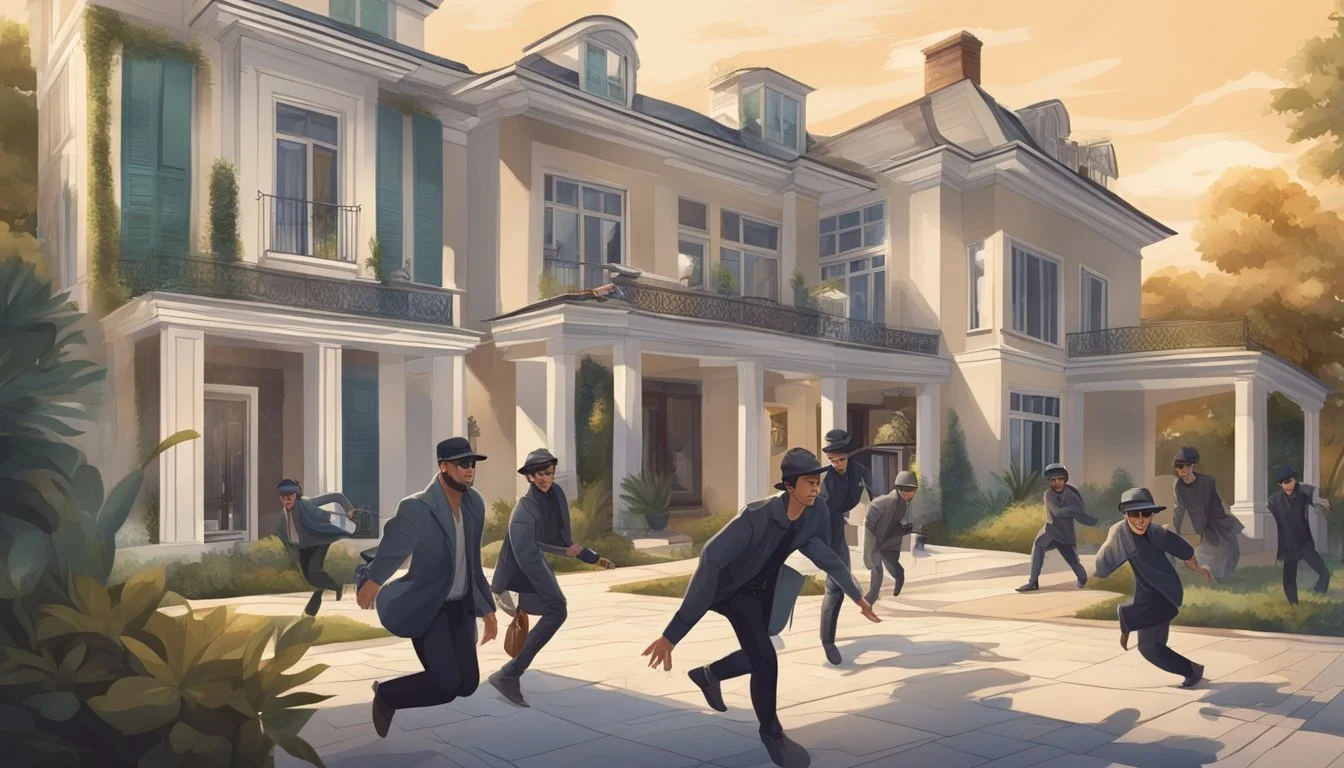Hollywood Heists: The Actual Events That Inspired 'The Bling Ring'
Celebrity Burglaries Exposed
In the late 2000s, a group of California teenagers made headlines for their audacious burglaries of celebrity homes. Known as the Bling Ring, these young thieves targeted high-profile figures like Paris Hilton, Lindsay Lohan, and Orlando Bloom. Between October 2008 and August 2009, they stole approximately $3 million worth of cash, clothing, and valuables from various Hollywood stars.
The real-life events of the Bling Ring captivated the public imagination, spawning multiple adaptations in popular media. Sofia Coppola's 2013 film "The Bling Ring" brought renewed attention to the case, with Emma Watson starring as a character inspired by one of the actual burglars. More recently, Netflix released a documentary series in 2022 titled "The Real Bling Ring: Hollywood Heist," offering a deeper look into the motivations and consequences of these young criminals.
The Bling Ring's story continues to fascinate audiences, blending elements of celebrity culture, teenage rebellion, and the dark side of fame. Their crimes exposed vulnerabilities in the security of Hollywood's elite and raised questions about the influence of social media and celebrity obsession on young people.
Origins of the Bling Ring
The Bling Ring emerged from a perfect storm of celebrity obsession, teenage rebellion, and easy access to information about stars' whereabouts. This group of young thieves targeted Hollywood's elite, driven by a desire for fame and luxury.
The Birth of a Hollywood Heist
The Bling Ring formed in 2008 in the affluent suburbs of Los Angeles. A group of teenagers from Calabasas High School bonded over their shared fascination with celebrity lifestyles. They began by breaking into unlocked cars in wealthy neighborhoods, stealing cash and credit cards.
Their activities escalated when they discovered how easy it was to find celebrities' home addresses online. The group started planning more ambitious heists, targeting the residences of famous personalities.
Key Members and the Ring's Ringleader
Rachel Lee, often considered the mastermind, led the Bling Ring. Her childhood friend Nick Prugo became her primary accomplice. Other key members included Alexis Neiers, Diana Tamayo, and Courtney Ames.
Lee's charisma and strategic planning skills made her the de facto leader. She carefully selected targets based on their fashion sense and jewelry collections.
Prugo's role involved researching celebrities' schedules and home layouts. His detailed knowledge proved crucial for successful break-ins.
Influence of LA's Celebrity Culture
Los Angeles' unique culture played a significant role in shaping the Bling Ring's motivations. The constant presence of celebrities and paparazzi created an atmosphere of perceived accessibility to fame.
Many Ring members attended high schools near Hollywood, regularly encountering stars and their lifestyles. This proximity fueled their desire to emulate the glamour they saw.
Social media and tabloid websites provided a constant stream of information about celebrities' lives. The teens used this data to plan their heists and feel connected to their targets.
Timeline of the Crimes
The Bling Ring's criminal activities spanned from October 2008 to August 2009, targeting several high-profile celebrities in Los Angeles. Their audacious burglaries netted millions in stolen goods and captivated the public's attention.
Notable Burglaries and Celebrities Targeted
The Bling Ring's first known target was Paris Hilton, whose home they burglarized multiple times. They stole designer clothes, jewelry, and cash from the socialite's residence.
Audrina Patridge's home was hit on February 22, 2009. The thieves made off with her jewelry and designer goods.
Lindsay Lohan's house was broken into on August 23, 2009. The group stole clothes, accessories, and personal items from the actress.
Rachel Bilson's property was targeted several times between April and May 2009. The burglars took designer clothes, jewelry, and Bilson's mother's engagement ring.
Major Heists: Paris Hilton to Orlando Bloom
Paris Hilton's home was the most frequently burglarized, with the group returning multiple times due to her habit of leaving a key under her doormat.
Estimated value of items stolen from Hilton: $2 million
Items taken: designer clothes, jewelry, cash
Orlando Bloom's residence was robbed on July 13, 2009. The thieves stole:
Rolex watches
Louis Vuitton luggage
The group also targeted Brian Austin Green and Megan Fox's home, stealing Green's semi-automatic handgun.
From Success to Slip-Up: The Events Leading to Arrests
The Bling Ring's downfall began when security cameras at Audrina Patridge's home captured images of two suspects. These images were released to the media, increasing pressure on the group.
A breakthrough came when a tipster recognized one of the suspects from the security footage. This led investigators to Nick Prugo, who eventually confessed and implicated his accomplices.
Police raids in October 2009 resulted in the recovery of stolen items from various members' homes. The arrests of Rachel Lee, Alexis Neiers, and other group members followed shortly after.
Media and Public Reaction
The Bling Ring case captivated the public and media, sparking extensive coverage across various platforms. The story's blend of celebrity, crime, and youth culture proved irresistible to news outlets and social media users alike.
Coverage by E! and Vanity Fair
E! News provided in-depth reporting on the Bling Ring, offering viewers exclusive details about the celebrity break-ins. Their coverage focused on the high-profile targets and the audacious nature of the crimes. Vanity Fair took a deeper dive, publishing Nancy Jo Sales' article "The Suspects Wore Louboutins" in 2010. This piece became the definitive account of the Bling Ring saga.
Sales' article explored the motivations and backgrounds of the young thieves, painting a picture of fame-obsessed teens in Los Angeles. The Vanity Fair story later served as the basis for Sofia Coppola's film adaptation, further cementing its cultural impact.
The Role of Social Media in Publicizing the Heists
Social media played a crucial role in both the execution and publicity of the Bling Ring's activities. The group used platforms like Facebook to track celebrities' whereabouts, enabling them to plan their heists more effectively.
Ironically, these same platforms became instrumental in spreading news about the crimes. Twitter and Facebook buzzed with updates, theories, and reactions as the story unfolded. The Bling Ring members' own social media accounts became subjects of intense scrutiny, offering glimpses into their lifestyles and personalities.
This online attention amplified the case's visibility, turning it into a viral sensation that transcended traditional news boundaries.
Impact on the Reputation of Involved Celebrities
The Bling Ring case had varying effects on the reputations of the targeted celebrities. Some, like Paris Hilton, became more sympathetic figures in the public eye. Others faced questions about their security measures and lifestyle choices.
Lindsay Lohan, already battling negative publicity, saw her troubles compound with the break-in. The incident added another layer to her troubled public image. Orlando Bloom and Miranda Kerr maintained a lower profile throughout the ordeal, minimizing potential damage to their reputations.
For many celebrities, the case highlighted the vulnerabilities that come with fame in the digital age. It sparked discussions about privacy and the dark side of celebrity culture.
The Legal Aftermath
The Bling Ring members faced various legal consequences for their actions. Court proceedings, sentencing, and rehabilitation efforts followed their arrests.
Court Cases and Sentencing
Rachel Lee, considered the ringleader, received a four-year prison sentence. She served about 16 months before being released on parole. Alexis Neiers pleaded no contest to felony burglary charges. She was sentenced to 180 days in county jail and three years of probation.
Nicholas Prugo, another key member, faced more severe consequences. He pleaded no contest to two counts of first-degree residential burglary. Prugo received a two-year prison sentence.
Diana Tamayo and Courtney Ames also faced charges. They accepted plea deals, resulting in probation and community service.
No Contest Pleas and Probation
Several Bling Ring members opted for no contest pleas to avoid lengthy trials. This strategy often led to reduced sentences and probation terms.
Roy Lopez Jr. pleaded no contest to receiving stolen property. He received three years of probation.
Courtney Ames entered a no contest plea to a misdemeanor charge. She was sentenced to three years of probation and time served in jail.
These plea deals allowed some members to avoid significant prison time. However, they still faced legal repercussions and ongoing supervision.
Community Service and Rehabilitation Efforts
As part of their sentences, many Bling Ring members were required to complete community service. This aimed to promote rehabilitation and give back to society.
Alexis Neiers performed 240 hours of community service. She also participated in a drug rehabilitation program during her probation period.
Diana Tamayo completed 60 days of community service. She worked to rebuild her life after the high-profile case.
Some members sought therapy and counseling to address underlying issues. These efforts focused on personal growth and preventing future criminal behavior.
Cultural Impact and Media Adaptations
The Bling Ring's audacious celebrity burglaries captivated public attention, spawning various media portrayals and influencing pop culture. Their exploits became the subject of reality TV, a major Hollywood film, and a Netflix documentary series.
The Infamy of 'Pretty Wild'
E! Network's reality show "Pretty Wild" inadvertently documented Alexis Neiers' involvement in the Bling Ring case. The series, intended to follow the lives of Neiers and her sisters, instead captured her legal troubles in real-time. Cameras rolled as Neiers faced arrest and trial, providing an unintended behind-the-scenes look at the Bling Ring saga.
The show's unexpected focus on the burglaries boosted its popularity. Viewers tuned in to witness Neiers' tearful phone calls from jail and her family's attempts to navigate the media frenzy. "Pretty Wild" lasted only one season but left a lasting impression on reality TV audiences.
Sofia Coppola's Film and Netflix Docuseries
Sofia Coppola's 2013 film "The Bling Ring" brought the teen burglars' story to the big screen. The movie starred Emma Watson as a character based on Alexis Neiers. Coppola's stylish adaptation focused on the allure of celebrity culture and the group's motivations.
The film received mixed reviews but sparked renewed interest in the case. In 2022, Netflix released "The Real Bling Ring: Hollywood Heist," a three-part docuseries. This production featured interviews with actual Bling Ring members, offering a more nuanced perspective on the events.
Influence on Fashion and Reality Television
The Bling Ring case left its mark on fashion and entertainment. The burglars' obsession with designer goods highlighted the power of luxury brands in youth culture. Their story inspired fashion editorials and runway collections that played with themes of excess and celebrity worship.
Reality TV producers took note of the public's fascination with the case. Shows featuring wealthy young people in Los Angeles became more prevalent. The Bling Ring's exploits also influenced how reality series portrayed crime and legal drama, blurring lines between entertainment and real-life consequences.
Personal and Psychological Perspectives
The Bling Ring case offers a window into the mindsets of young people driven to crime by an obsession with celebrity culture and material wealth. Their actions reveal complex motivations and societal influences.
Insights into the Thieves' Motivations
The Bling Ring members were fueled by a potent mix of celebrity worship and materialism. They craved the glamorous lifestyles they saw portrayed in media and social networks. For some, the thrill of breaking into celebrity homes provided an adrenaline rush and sense of power.
Nick Prugo, a key member, described feeling invisible in high school. The robberies gave him a taste of fame and acceptance he desperately sought. Alexis Neiers claimed she participated to fund a drug habit, highlighting how substance abuse intersected with their criminal activities.
The teens' actions also stemmed from a sense of entitlement. Growing up in affluent areas near Hollywood, they felt deserving of the same luxuries as their celebrity neighbors.
Consequences of Fame and Material Obsession
The Bling Ring case exemplifies the dark side of fame obsession and materialism in youth culture. The thieves' fixation on designer goods and celebrity possessions reveals a culture that equates material wealth with self-worth and status.
This obsession had severe consequences. The teens faced legal repercussions, with some serving jail time. Their actions damaged relationships with family and friends. The notoriety also brought unwanted attention and scrutiny to their lives.
The case highlights how the pressure to maintain a certain image on social media can drive young people to extreme behaviors. It serves as a cautionary tale about the dangers of prioritizing material possessions and fame over personal integrity.
Discussions on Youth and Morality in Modern Society
The Bling Ring sparked debates about morality and values among young people in the digital age. Critics argued that excessive exposure to celebrity culture and social media warped the teens' sense of right and wrong.
Others pointed to a lack of parental guidance and supervision as a contributing factor. The case raised questions about how to instill ethical values in a society that often glorifies wealth and fame above all else.
The incident also highlighted the need for media literacy education. Teaching young people to critically evaluate the images and lifestyles portrayed in media could help prevent similar situations in the future.







